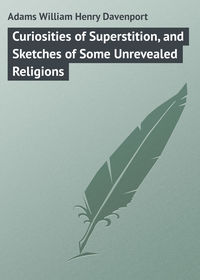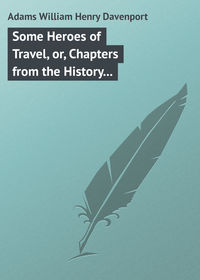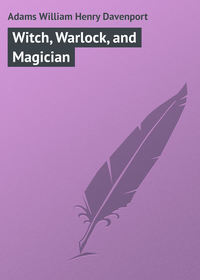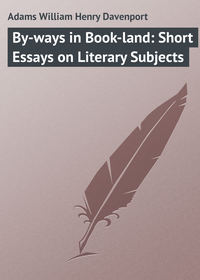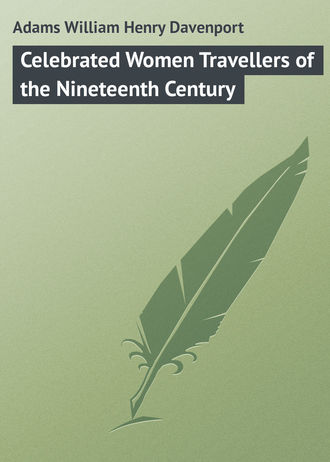 полная версия
полная версияCelebrated Women Travellers of the Nineteenth Century
"This period of my life," wrote Madame de Hell, afterwards, "spent in the midst of the steppes, remote from any town, appears to me now in so calm, tender, and serene a light, that the slightest memorial of it moves me profoundly. Only to see the shore where we passed whole days in seeking for shells, only to hear the sound of the great waves rolling on the sandbanks and among the seaweed, only to recall a single one of the impressions of that happy epoch, I would willingly repeat the voyage."
For his great scientific expedition, M. de Hell made vigorous preparations during the winter of 1838, and having obtained from Count Vorontzov, the governor of New Russia, strong letters of recommendation to the governors and officials of the provinces he would have to traverse, he and his wife started in the middle of May, 1839, accompanied by a Cossack, and an excellent dragoman, who spoke all the dialects current in Southern Russia.
Their journey through the country of the Don Cossacks we shall pass over, as offering nothing of special novelty or interest, and take up Madame de Hell's narrative at the point of her arrival on the banks of the Volga.
"A dull white line," she says, "scarcely perceptible through the gloom, announced the presence of the great river. We followed its course all night, catching a glimpse of it from time to time by the faint glimmer of the stars, and by the lights of the fishermen's lanterns flashing here and there along its banks. There was an originality in the scene that strongly affected the imagination. Those numerous lights, flitting from point to point, were like the will-o'-the-wisps that beguile the belated traveller; and then the Kalmuk encampments with their black masses that seemed to glide over the surface of the steppe, the darkness of the night, the speed with which our troika (set of three) carried us over the boundless plain, the shrill tinkle of the horse-bells, and, above all, the knowledge that we were in the land of the Kalmuks, wrought us up to a state of nervous excitement that made us see everything in the hues of fancy.
"At daybreak our eyes were turned eagerly towards the Volga, that flashed in the glories of the morning sky. From the elevation we had reached we could survey the whole country; and it may easily be conceived with what admiration we gazed upon the calm majestic river, and on its multitude of islands, fringed with aspen and alder. On the other side, the steppes, where the Kirghiz and Kalmuks encamp, extended as far as the eye could reach, till limited by a horizon as smooth and uniform as that of the ocean. It would be difficult to imagine a grander picture, or one more entirely in harmony with the ideas evoked by the Volga, to which its course of upwards of six hundred leagues assigns the foremost place among European rivers."
At the outset of her journey, Madame de Hell had exclaimed: "What happiness it is to escape from the prosaic details of every-day life, from social obligations, from the dull routine of habit, to take one's flight towards the almost unknown shores of the Caspian! It is strange, but it proves that my vocation is that of tourist, that what would daunt the majority of women is really what charms me most in the forecast of this journey."
Assuredly, the details of every-day life were left behind when the courageous lady embarked upon the Volga, and set out for the famous city of Astrakhan. All around her was new and strange, and each day, each hour, brought before her eager mind some fresh subject of speculation. She paid a visit to a Kalmuk prince, Prince Tumene, and found herself in the midst of a new world. The prince's palace was built, she says, in the Chinese style, and pleasantly situated on the green side of a gentle slope, about one hundred feet from the Volga. Its numerous galleries afforded views over every part of the island on which the palace was situated, and commanded a long reach of the shining river. From one angle the eye looked down on a mass of foliage embosoming the glittering cupola and the golden ball above. Beautiful meadows, studded with clumps of trees, and highly cultivated fields, spread out their verdure to the left of the palace, and formed a succession of landscapes, like pictures in a panorama. The whole was enlivened by the figures of Kalmuk horsemen galloping to and fro, of camels wandering here and there through the rich pastures, and officers conveying the orders of their chief from tent to tent. The spectacle was imposing; various in its details, but harmonious as a whole.
Madame de Hell was invited to visit the prince's sister-in-law, who, during the summer season, resided in her kibitka in preference to the palace. The curtain at the threshold of the pavilion having been raised, she was ushered into a spacious room, lighted from above, and draped with red damask, the reflection from which shed a glowing tint on every object; the floor was covered with a rich Turkey carpet, and the air was heavy with perfumes. In this rosy light and balmy atmosphere was seated the princess, on a low platform at the further end of the tent, dressed in shining robes and motionless as an idol. Around her, crouching on their heels, were arranged some twenty women in full dress. Having allowed Madame de Hell a few minutes to admire her, the princess slowly descended the steps of the platform, approached with a dignified bearing, took her by the hand, embraced her affectionately, and led her to the seat she had just vacated. Through the medium of an Armenian interpreter a brief conversation followed, after which she made signs that dancing should begin. One of the ladies of honour then rose and performed a few steps, turning slowly upon herself; while another, who remained seated, drew forth from a balalaika (an Oriental guitar) certain doleful sounds, ill-adapted to the movements of a dancer. Nor were the attitudes and movements of her companion so much those of the dance as of the pantomime. There was evidently a meaning in them, though Madame de Hell could not unravel it. The young figurante frequently extended her arms and threw herself on her knees, as if in invocation of some unseen power.
The performance lasted for some considerable time, and Madame de Hell had ample opportunity of scrutinizing the princess, and of coming to the conclusion that her high reputation for beauty was not undeserved. Her figure was imposing and well-proportioned. The lips, beautifully arched and closing over pearly teeth; the countenance, expressive of great sweetness; the skin, of a brownish tint, but exquisitely delicate, would entitle her to be considered a very handsome woman, even in France, if the outline of her face and the arrangement of her features – the oblique eyes, the prominent cheek-bones – had been less pronouncedly Kalmuk.
A word as to her costume. Over a costly robe of Persian stuff, laced all over with silver, she wore a light silk tunic, open in front, and descending only to the knee. The high corsage was quite flat, and glittered with silver embroidery and fine pearls that covered every seam. Round her neck she wore a white cambric habit-shirt, in shape not unlike a man's collar (forty years ago), and fastened in front by a diamond button. Her luxuriant deep black hair fell over her bosom in two magnificent and remarkably long tresses. A yellow cap, edged with rich fur, and fashioned like the square cap of a French judge, was set jauntily on the crown of her head. But in her costume the two articles that most surprised Madame de Hell were an embroidered cambric handkerchief and a pair of black mittens, significant proofs that the products of the French loom found their way even to the toilet of a Kalmuk lady. Among the princess's ornaments must not be forgotten a large gold chain, which, after being twisted round her glossy tresses, was passed through her gold earrings and then allowed to fall upon her bosom.
Madame de Hell was afterwards entertained with a specimen of Kalmuk horsemanship. The moment she came out into the open, five or six mounted men, armed with long lassoes, rushed into the middle of the taboon, or herd of horses, collected for the purpose, keeping their eyes constantly on the princess's son, Madame de Hell's companion, who was to point out the animal they should seize.
At the signal, they immediately galloped forward and noosed a young horse with long dishevelled mane, whose dilated eyes and smoking nostrils revealed his inexpressible terror. A lightly clad Kalmuk, who followed them a-foot, sprang instantly upon the stallion, cut the thongs that were throttling him, and engaged with him in a contest of incredible agility and daring. It would scarcely be possible for any spectacle more vividly to affect the mind than that now presented to Madame de Hell's astonished gaze. Sometimes rider and horse rolled together on the grass, sometimes they shot through the air with arrowy speed, and then suddenly halted as if a wall had sprung up before them. All at once the impetuous animal would crawl on its belly, or rear in a manner that made the spectators shriek with terror, then, plunging forward in a mad gallop, he would dash through the startled herd, seeking by every possible means to rid himself of his unaccustomed burden.
But this exercise, violent and perilous as it looked to Europeans, seemed but sport to the Kalmuk, whose body followed every movement of the animal with so much suppleness, that one might have supposed both steed and rider to be animated by the same thought. The sweat poured in profuse streams from the stallion's flanks, and he trembled in every limb. As for the rider, his coolness would have put to shame the most accomplished horseman in Europe. In the most critical moments he contrived so far to retain his self-command as to wave his arms in token of triumph; and, in spite of the passion and temper of his untrained steed, held sufficient control over it to keep it always within the circle of the spectators' vision. At a signal from the prince, two horsemen, who had remained as close as possible to the daring centaur, seized him with astonishing swiftness, and galloped away with him before those who looked on could understand the new manœuvre. The horse, for a moment stupefied, soon darted away at full speed and was lost in the midst of the herd. This exploit was several times repeated, and always without the rider suffering himself to be thrown.
Madame de Hell's account of the Kalmuks is, on the whole, very favourable, while it shows how closely she studied their manners and customs, and the habits of their daily life. As to physical details, she says that the Kalmuks have eyes set obliquely, with eyelids little opened, scanty black eyebrows, noses deeply depressed near the forehead, prominent cheek bones, spare beards, thin moustaches, and a brownish-yellow skin. The lips of the men are thick and fleshy, but the women, particularly those of the higher classes – the "white bones," as they are called – have heart-shaped mouths of more than ordinary beauty. All have great ears, projecting strongly from the head, and their hair is invariably black.
The Kalmuks are generally small, but with well-rounded figures and an easy carriage. Very few deformed persons are seen among them; for, with the wisdom of nature, they leave the development of their children's frames unchecked, nor, indeed, do they put any garments upon them until they reach the age of nine or ten. No sooner can they walk than they mount on horseback, and address themselves vigorously to wrestling and riding, the chief amusements of the tribes.
Like all who dwell upon vast plains, they enjoy an exceedingly keen sight. An hour after sunset they can distinguish a camel at a distance of upwards of three miles. Madame de Hell tells us that often when she could see nothing but a point on the horizon, they would clearly make out a horseman armed with lance and gun. They have also an extraordinary faculty for tracing their way through the pathless wildernesses. Without any apparent landmarks they would traverse hundreds of miles with their flocks, and never deviate from the right course.
The costume of the common Kalmuks exhibits no decided peculiarity, apart from the cap, which is invariably of yellow cloth trimmed with black lambskin, and is worn by both sexes. Madame de Hell seems inclined to think that some superstitious notions are connected with it, from the difficulty she experienced in procuring a specimen. The trousers are wide and open below. The well-to-do Kalmuks wear two long tunics, one of which is fastened round the waist, but the usual dress consists only of trousers and a jacket of skin with tight sleeves. The men shave a part of their heads, and the rest of the hair is collected into a single cluster, which hangs down on the shoulders. The women wear two tresses, which is really the sole visible distinction of their sex. The princes have adopted the Circassian costume, or the uniform of the Astrakhan Cossacks, to which body some of them belong. The ordinary chaussure is red boots with very high heels and generally much too short. The Kalmuks have almost as great a partiality for small feet as the Chinese, and, as they are constantly on horseback, their short boots cause them no great inconvenience. But for these reasons they are very bad pedestrians, their "cribbed, cabined, and confined" foot-gear obliges them to walk on their toes; and their distress is great when they have no horse to mount.
Like all pastoral people, the Kalmuks live frugally, because their wants are few, and their nomadic life is unfavourable to the growth of a liking for luxuries. They live chiefly upon milk and butter, with tea for their favourite beverage. Their bill of fare also includes meat, and particularly horse-flesh, which they prefer to any other, but they do not eat it raw, as some writers have pretended. As for cereals, which Europeans value so highly, their use is scarcely known; it is at rare intervals only that some of them buy bread or oatcake from the neighbouring Russians. Their mode of preparing tea would not commend itself to the denizens of Mayfair. It comes to them from China in the shape of very hard bricks, composed of the leaves and coarsest portions of the plant. After boiling it for a considerable time in water, they add milk, butter, and salt. The infusion then acquires consistency, and a dull red colour. "We tasted the beverage," says Madame de Hell, "at Prince Tumene's, but must confess it was perfectly detestable… They say, however, that one easily gets accustomed to it, and eventually learns to think it delicious. It has, however, one good quality. By strongly stimulating perspiration it serves as an excellent preservative against the effect of sudden chills. The Kalmuks drink it out of round shallow little wooden vessels, to which they often attach a very high value. I have seen several," adds our traveller, "which were priced at two or three horses. They are generally made of roots brought from Asia. It is scarcely necessary to say that the Kalmuks know nothing of tea-kettles, and make their beverage in large iron pots. Next to tea, they love spirituous liquors. From mare's milk or ass's milk they manufacture a kind of brandy; but as it is a very feeble stimulant, they eagerly seek after Russian liquors; and therefore, to prevent the fatal consequences of their mania, the government has forbidden the establishment of any dram-shops among their hordes. The women crave the deadly liquor no less ardently than the men, but are so closely watched by their lords and masters that they have few opportunities of indulging the taste."
Among the Kalmuks, as among most Oriental peoples, the stronger sex looks with contempt upon all household matters, abandoning them entirely to the women; who work and take charge of the children, keep the tents in order, make up the garments and furs of the family, and attend to the cattle. The men hardly condescend to groom their horses; they hunt, drink tea or brandy, doze about upon felts, and smoke or sleep. Add to their daily occupations, if such they can be called, their joining in occasional games, such as chess and knuckle-bones, and you have a complete picture of the existence – we will not say life – of a Kalmuk paterfamilias. At their laborious days, however, the women never repine; they are accustomed to the burden, and bear it cheerfully; but they age very early, and after a few years of wedlock, not only lose their good looks, but acquire a coarseness of feature and a robustness of figure which make it exceedingly difficult to distinguish them from men. Nor is the difficulty lessened by the fact that the costume of both sexes is closely alike.
At Astrakhan the most dangerous as well as the most arduous part of the expedition of our two travellers began. They were compelled to carry provisions with them, if they did not wish to perish of hunger on the steppes. An escort was therefore necessary, and the Russian governor selected for the post one of his best officers; a young man famed for his skill as a hunter, and as the happy owner of a falcon from which he would never separate. Satisfied with providing so competent a purveyor, the governor, in presenting him to the travellers, said; "Now my conscience is at rest! I give you a brave soldier to protect you, and a travelling companion who will take care that you are not starved to death in the desert."
From Astrakhan they pushed forward to Vladimirofka, a town on the Kuma, which they entered with a good deal of pomp and circumstance. A britchka, drawn by three camels, and carrying Monsieur and Madame de Hell, led the van; then came a troop of four or five Cossacks, armed to the teeth, and several Kalmuks guiding a train of camels loaded with baggage. The Cossack officer, with falcon on wrist, and his long rifle slung behind him, rode by the side of the carriage, ready, with Muscovite precision, to transmit orders to the escort, and gallop off at the slightest signal; whilst the dragoman lolled on the box-seat with a fine air of contemptuous indifference to everything around him. After a few days' rest and refreshment, they resumed their journey, advancing rapidly towards the Caucasus, of which the highest summit, Mount Elburz, from time to time afforded them a glimpse of its lofty head, which was almost always shrouded in mist, as if to conceal it from the profane gaze. Tradition avows that Noah's dove alighted on its peak, and plucked thence the mystic branch which has ever since been hallowed as symbolic of peace and hope.
"We were now," writes Madame de Hell, "in an enchanted region, though but just beyond the verge of the steppes. The faint lines that chequered the sky gradually assumed a greater distinctness of form and colour; at first the mountains seemed so many light, transparent vapours, floating upon the wind; but by degrees the airy vision developed into forest-crowned mountains, deep shadowy gorges, and domes clothed with mists. Our minds were almost overwhelmed with a multitude of emotions, excited by the prodigal nature before us, the magnificent vegetation, and the various hues of forest and mountain, peak, crag, ravine, and snowy summits. It was beautiful, superbly beautiful, and then it was the Caucasus! The Caucasus – a name associated with so many grand historic memories, with the earliest traditions and most fabulous creeds – the abode, in the world's grey morning, of the races whence have sprung so many famous nations. Around it hangs all the vague poetry of the ages, visible only to the imagination through the mysterious veil of antiquity."
At Georgief they rested on the threshold of the Caucasus. Thence they proceeded to Piatigorsk, celebrated for its mineral waters. On the road they fell in with a troop of Circassians. "I shall never forget," says Madame de Hell, "the glances which they flung on our Cossacks as they passed by, though it was only in looks they durst manifest the hatred that seethed in their hearts against everything Russian. They were all fully armed. Beneath their black bourkas glittered the sheen of their pistols and their damasked poniards. I confess their appearance pleased me most when they were just vanishing from sight on the summit of a hill, where their martial figures were outlined against the sky. Seeing them through the mist, I began to think of Ossian's heroes."
Piatigorsk is not so much a town as a pleasant cluster of country-houses, inhabited for some months of the year by a rich aristocracy. All about it is gay and pretty, and everywhere are those signs of affluence which the Russian nobles love to see around them. Nothing offends the eye; nothing touches the heart; there are no poor, no squalid huts, no indication of the wretchedness of poverty. It is a terrestrial Elysium, where great ladies and princes, courtiers and generals, look out upon none but agreeable images, selected from all that is charming in art and nature. Thermal springs are found on most of the surrounding heights, and the works that afford access to them do credit to the skill of the Russian engineers and the liberality of the Russian government. On one of the loftiest peaks rises an octagonal building, consisting of a cupola resting upon slender shapely columns, which are encircled at their base by a graceful balustrade. The interior, open on all sides, contains an Æolian harp, the melancholy notes of which, blending with all the mountain echoes, descend softly to the valley.
The route of our travellers, after quitting Piatigorsk, lay along the broad deep valley of the Pod Kouwa, which, on the right, is bounded by rocks piled one upon another, like billows suddenly petrified, and bearing witness to some great upheaval in the past; on the left, tier after tier of richly wooded mountains rise gradually to the majestic chain of the Kazbek. Eventually the road leaves the valley, at a point where it has become very narrow, and traverses a long sinuous ledge, parallel with the course of the torrent, until it begins to enter the mountains. Here the miry soil through which their horses had laboured with much difficulty, and the grey sky, and the moist atmosphere that had hitherto accompanied them, were at once exchanged for a dry air, cold, dust, and sunshine. This sudden contrast is a phenomenon peculiar to elevated regions.
Madame de Hell was strongly impressed by the wild picturesque character of the scenery of this part of the Caucasus. At certain intervals, conical mounds of earth, about sixty feet high, stood conspicuous – watch towers, where sentinels are stationed day and night. Their outlines, sharply marked against the sky, produce a curious and striking effect amidst the profound solitude. The sight of these Cossacks, with muskets shouldered, pacing up and down the small platform on the summit of each eminence, conveyed to the spectator's mind a knowledge of the rapid advance which Russian civilization had made into this remote region.
It was mid-October, but vegetation still retained its freshness. The steep mountain sides were covered with rich greenswards, which afforded abundant pasture for the scattered flocks of goats. Their keepers, clothed in sheepskins, and carrying, instead of the traditional crook, long guns slung across their shoulders, with two or three powder and ball cases at their waists, seemed in strange contrast to the pastoral sentiment of the landscape. Gigantic eagles, roused from their eyries, swept with heavy wing from crag to crag, the monarchs of these solitudes. Here our travellers really looked out upon those features of the Caspian wilderness on which their imaginations had so often dwelt.
Of the Circassian inhabitants of this mountain region, before they were completely subjugated by the despotism of the white Czar, Madame de Hell furnishes a graphic account. Bred amid the sights and sounds of war they went always well armed, carrying a rifle, a sabre, a long dagger, which they wore in front, and a pistol in the belt. Their picturesque costume consisted of tight pantaloons, and a short tunic, which was belted round the waist, and had cartridge pockets worked on the breast; a round laced cap, encircled with a black or white border of long-wooled sheepskin, formed their head-gear. In cold or rainy weather, they wore a bashlik, or hood, and a bourka, or cloak, of impervious felt. They were bold and skilful riders, and their horses, though small, were remarkable for spirit and endurance. It is well known that a Circassian horseman would cover twenty-five or even thirty leagues of ground in a night. When pursued by the Russians, they would leap the most rapid torrents. If their steeds were young, and unaccustomed to such perilous exploits, they would gallop them up to the brink of the ravine, cover the head with their bourkas, and then dash, almost always without mishap, down precipices from twenty to fifty feet in depth.




